Hawkeye Vol.1: My Life As A Weapon tpb (Marvel, $14.99)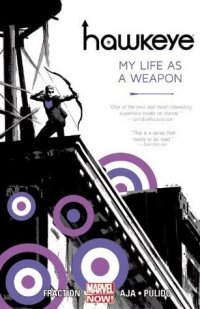
by Graig Kent
After reading this trade, I’m certain I could only read Hawkeye and be happy not reading any other comic book ever, at all, period. Just Hawkeye from now on, that’s it. It’s that good. As good as I had heard. Better even. Considering I haven’t heard a bad thing about it, I was kind of expecting it to let me down a little. It did not.
I’m not really going to stop reading other comics, but seriously Hawkeye is virtually everything I Iook for in a comic book. Writer Matt Fraction has tapped into all the superhero tropes I love: the flawed hero, a sense of character and (fictional) history as well as thematic legacy, and capturing both the hero’s perspective as well as the everyman’s, giving the reader a very well-rounded look at a world with super heroes in it. We see the fantastic as well as the mundane and both of it is great. Fraction uses humor to great effect, situation and character-specific. The comedy is wry, original, and seemingly effortless (his use of the old translated word balloon is inspired).
I was pondering recently whether all the many female heroes I adore (She-Hulk, Spider-Woman, Batwoman etc.) are somewhat marginalized by being, at least in conception (and in name), derivatives of male counterparts, and if they are somewhat diminished by having no unique brand identity of their own (I think Red She-Hulk is the absolute worst example of this, doubly qualified). But here, in Hawkeye, Clint Barton has adopted Young Avengers’ Hawkeye Kate Bishop (who took his superhero moniker while he was deceased/operating as Ronan) as a nearly equal partner, allowing her to remain Hawkeye even as he has reclaimed the name (because he’s in movies y’ know). I also enjoy tremendously how much Clint and Kate enjoy calling one another “Hawkeye” in action. While it’s Clint’s book, Kate is the breakout star, proving to be more level-headed than her senior counterpart, and frequently pulling his fat out of the fire.
Yet, putting Clint in this light, vulnerable, brash, emotional, cocky with a sense of fearlessness and a seeming disregard to his own mortality, helps put him into a whole new realm of likeability, where for many readers, he may not have been before. Clint is hyper-aware of his place in the world, especially on the Avengers, and seems comfortable with just waking up every day. With the exception of his exceptionally honed marksmanship, here Hawkeye is the most average superhero.
Clint has a penchant for falling out/ getting thrown out/jumping out of windows as well as getting knocked on the head. I’d be thrilled if Fraction started dealing with Clint’s concussion-like symptoms as an ongoing thread. It’s the kind of book that can handle a “now” and very mortal topic with both tact and humour.
I liked David Aja with Fraction on Iron Fist but I love him here. Dynamic, creative and deceptively simple, his use of silhouettes is masterful and his comedic timing is on par with the greats like Kevin Maguire, Keith Giffen and Kyle Baker. It’s so damn delightful. Javier Pulido does a good job as fill-in but just doesn’t have the same pizzazz as Aja. But these two are so good they make Alan Davis, a legend by no small means, look kind of average and mundane in comparison (in the reprinted Young Avengers Presents #6).
I may have to add this to my monthly pickups since I don’t know if I can wait for the next trade. And you know, only a few days ago I couldn’t have cared less about Hawkeye.
Rating: 




Out of a Possible 5 Stars
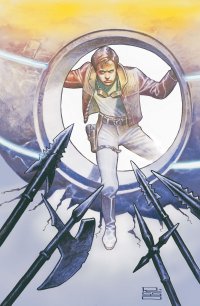 Time Warp #1 ($7.99, Vertigo)
Time Warp #1 ($7.99, Vertigo)
by D.S. Randlett (@dsrandlett)
As you well know, Vertigo has been rather quiet lately. After all, the label began life on the heels of books like Alan Moore’s Swamp Thing as a way to separate the DCU’s more mature fare from the delicate post-Crisis rebuilding effort. With the New 52, we’ve seen those Vertigo characters reintegrated and rebranded into the DCU. So what about Vertigo’s other side, the side that pioneered the modern non-capes and tights American comic book? It could be argued that other publishers have taken up that standard as Vertigo has become less prolific. Dark Horse has been publishing The Massive and MIND MGMT, and Image is publishing Fatale and Saga. As little as five years ago, these would, in all likelihood, have been Vertigo books. So I suppose the question becomes: Is Vertigo still needed? That is not a question that I can answer, but I can say that it is at the very least encouraging to see DC holding the line in the wake of Karen Berger’s departure with series like The Unwritten and anthologies like Time Warp, despite the one shot’s mixed success.
The one shot anthology format can be rather maddening. These are typically full of what feel like pitches for longer form series, which gives some stories the feeling of too much being held to the creative teams’ vests. Or else they are mere exercises in style, which is fine in one sense, but like the previous case they rarely leave the reader feeling full. There is some of that in Time Warp, the most egregious offender being the opening story, featuring Rip Hunter: Time Master, written by Damon Lindelof and featuring art by Jeff Lemire. It’s a fine enough idea, but it’s written in that decompressed “TV/Movie guy doing comics” way that ensures you’ll be done reading it in thirty seconds. Even for its slightness, the Lindelof/Lemire piece does not even come close to approaching the banality of the entry into the Dead Boy Detectives series that has been running through these Vertigo anthologies, an airy chase story not written by Neil Gaiman that features everything you hate about Neil Gaiman.
Most of the shorts here are pretty decent, but nothing that will change your world save for some of the cooler ideas (in fact, basically all Matt Kindt’s entry seems to be is a collection of really cool SF ideas) or great art embedded here and there. And it must be said that, apart from the Dead Boy Detectives story, the art in this collection is uniformly excellent. A highlight here is the Ray Fawkes/Andy Macdonald piece, 0:00:03, which features some absolutely stunning artwork despite a rather slight story.
There are two narrative standouts here, and I don’t think it’s coincidental that they both eschew the time travel motif and instead look to different Sci-Fi conceits in order to examine how time feels. First, there is the hilarious story by Simon Spurrier and Michael Dowling, The Grudge. The story unfolds from a lecture given by a leading scientist, who is recounting his feud with another leader in his field. This feud takes the form of a tagging war, with each scientist continually finding a way to one up the other in terms of finding a yet more complicated way to write something filthy upon the fabric of existence. There’s more to the story than that, of course. There’s an examination of grief there, as well as a critique of an increasingly shallow media culture. The other standout, and a look at grief’s dark edge is the story She’s Not There, by Peter Milligan and M.K. Perker (and edited by Karen Berger!), which is told from the point of view of a manufactured ghost who has been created/hired to haunt the house of a man who’s lost his wife. It’s a story that examines grief and memory as forms of possessiveness that could easily support a novel, but Milligan’s writing keeps things focused so that 8 pages feels like enough.
Those two stories are easily worth the price tag, which is more than I can say for a lot of the twenty two page books retailing for two bucks. While the other stories in the collection aren’t quite up to that standard, there’s something to like in nearly all of them.
Rating: 




Out of a Possible 5 Stars
The Private Eye #1 (The Panel Syndicate, Online—Pay what you want)
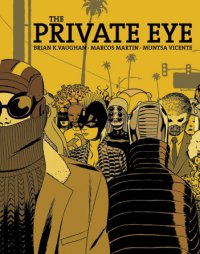
By Adam Prosser
There’s nothing technically revolutionary about The Private Eye, by Brian K. Vaughan and Marcos Martin. It’s a digital comic, a venue that’s exploded lately. It’s made by a couple of talented creators working under an indie label, of which there’s been a veritable exodus in the past year or so. And it’s on the “Pay what you want” model most commonly associated with Radiohead’s online album In Rainbows. So nothing about this comic is a first, per se, but something about the intersection of all these aspects makes it feel “next level” to some small degree—like another small step on the road to a wildly different economy for art and entertainment.
Which isn’t inherently a good thing, I hasten to add. As with the much-discussed Veronica Mars kickstarter of a few weeks back, there are some inherent pitfalls in the idea of making creative work contingent on handouts or patronage. For starters, only a hot team like Vaughan and Martin could really get the attention and support that a book like this needs to stay profitable; for people starting out, this kind of model could be undermining the idea that you deserve to get a stable paycheck for your work. But by the same token, being able to bypass the gatekeepers of culture is an exciting prospect for people with something important to say.
I bring this up because this double-edged technological and cultural sword is actually part of the theme of The Private Eye. Perhaps 50 years in the future, some kind of unspecified internet event referred to as “The Cloudburst” has rendered privacy obsolete. Everything about you, even stuff that was supposed to remain protected, can now be discovered with a few keystrokes. People have responded to this by attempting to conceal their real-world selves behind masks, costumes, and strange new identities; the internet, or this aspect of it at least, has seemingly leaked out into meatspace. In this new society, paparazzi have suddenly taken on a role similar to, well, private eyes, snapping candid photos of people out of costume, attempting to link made-up identities with the records of actual human beings online. Of course, given the situation, this also happens to be wildly illegal, as we see when our protagonist “Patrick Immelmann” (not his real name, natch) is forced to make a daring escape from the police simply for taking some candid snaps. Even after escaping, “Patrick” is quickly enmeshed in an even more sordid and dangerous situation with shades of Raymond Chandler.
Back when Brian K. Vaughan was making a name for himself with Y: The Last Man and Ex Machina, I was definitely hooked on his stuff but I had some reservations…primarily the fact that, for all his storytelling skill, I never felt like Vaughan was making full use of the medium. He tended to write a lot of “people in street clothes having conversations”-type scenes, which were then dutifully rendered by artists of the “classical realism” school. He felt, in essence, like a guy who’d rather be writing for TV, a comparison that was not lessened by his joining the writing staff of Lost. But ever since Vaughan’s returned to the medium that birthed his career, he seems to have taken a new tack; perhaps realising that his efforts now actually have a shot at being transferred to film, he’s started to tailor his stuff more to the stylized, dense medium of comics. The result has been a wilder, more imaginative Vaughan, with the baroque Sci-Fantasy universe of Saga, and now The Private Eye. TPE is less fantastical, though it evokes Warren Ellis’s Transmetropolitan at points, but it’s brought to life in a more stylized fashion. Credit is due here, obviously, to Marcos Martin, whose style is somewhere between Paul Pope’s and Gabriel Ba’s—deceptively simple when focused on the characters, yet intricate when world-building is called for. In particular, the lush colours help to create a compelling, immersive book, evoking some of the feel of cyberpunk anime like Akira. Even more so than Saga, it feels like Vaughan here is willing to let the art bear some of the load of storytelling, and to take a step away from reality into the world of stylization. It’s an impressive creative progression for him, and I’m excited that someone as successful as he is is willing to make it on his own terms. Vaughan could have used comics as a stepping stone and then abandoned the medium forever; it’s gratifying to see him still granting the medium his interest and respect.
Rating: 




Out of a Possible 5 Stars
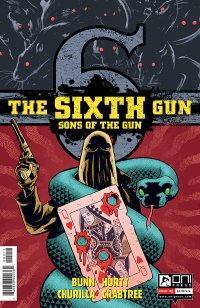 The Sixth Gun: Sons of the Gun #1 & 2 (of 5) (Oni Press, $3.99)
The Sixth Gun: Sons of the Gun #1 & 2 (of 5) (Oni Press, $3.99)
by Graig Kent
The motto in comics today seems to be “if it’s a success, franchise it”. And why not? If people are responding to your product, make more of it. It’s why Green Lantern emerged in the New 52 with two additional titles in the lineup. The Avengers and the X-Men brands over at Marvel have taken over almost completely, and Batman and Superman at DC seem to be dominating half of their publishing output. But you see it elsewhere as well, at Vertigo with Fables and American Vampire of late going all the way back to Sandman. Dynamite has particularly been making little cottage industries out of most of its licensed properties, like the Warlord of Mars and Green Hornet. But this is nothing new, franchising your popular title is a proven sales boon for the publisher (even if most offshoots perform less than 100% of the main title) through the ages of comics. How many Captain Marvel related titles were there in the Golden Age, or how many Superman-affiliated books were there?
I’m fairly certain that almost every instance of a franchise title is born out of the capitalistic model, rather than an artistic one, which isn’t to say that there’s no artistic merit in the endeavor, or that they’re inherently cynical in nature. Quite the contrary. I think that the franchising of titles can lead to exceptional creativity, allowing the same creators to explore characters in a different manner than the main title, or allowing different creators the opportunity to work with the characters, or allowing less popular characters to take the spotlight… if editors and creators are doing it right, there’s a lot of effort put into finding the right way to take something that works, and enhance it, not just cannibalize it. The Sixth Gun: Sons of the Gun isn’t a necessary off-shoot of the main series but it is a welcomed one.
The world of The Sixth Gun is a fascinating one, a brilliant melding of the old west with the supernatural. Cullen Bunn and Brian Hurtt, over nearly 30 issues, have crafted a very specific brand of western, one that operates with it’s own set of metaphysics, and with an ever-expanding cast of characters all with some relationship to one of the six enchanted six-shooters of which the titular armament is a part. It’s not that it’s all necessarily well-defined, but instead Bunn and Hurtt keep it all extremely consistent, which is even more valuable than a clearly understood set of ghost rules. The series seems to operate under the specter of Oleander Hume, a Confederate General and sorcerer who manifested the six guns, which he originally doled out to four of his lieutenants and his wife, keeping one for himself.
Sons of the Gun is a 5-issue series of apparently stand-alone, yet tangentially connected stories that each focus on the men and woman whom first possessed these guns, and the effect owning these cursed weapons had on their physical and mental well-being. The first issue opens with a flash of General Hume’s “final” interaction with the men who condemned him, then sets on to follow “Bloodthirsty” Bill Sumter, owner of the first gun, which can strike with the force of a cannon. Sumter, having hit desperate times since the General’s demise, takes up with a group of mystical artifact hunters, which spells trouble should they learn of the artifact Sumter himself carries. The second book follows “Filthy” Ben Kinney, holder of the third gun which spreads a flesh-rotting disease. Kinney faces a crisis of conscience with the atrocities he commits with his weapon and the toll it takes on him as he appears afflicted by plague himself. He abandons his gun and violent ways, finding sanctuary in the barn of a sympathetic townsman. While hidden away he becomes taken with a young woman in town and begins to unburden his soul to her by way of letters. But he can’t escape his past when Bloodthirsty Bill shows up with his gun. Though at first appearance these stories are largely disconnected, I won’t be surprised if there’s a greater arc in play.
Bunn and Hurtt are using this series to expand upon characters introduced in the first arc, where they may have been portrayed a little less… complicated. As well, it serves the purpose of showing what kind of impact these guns and their use has had on these men (and inform the effect it could be having on the protagonists of the main series). As with the main series it’s utterly captivating, and complimentary tonally. Though Hurtt doesn’t illustrate it, there’s no better choice for substitute than Brian Churilla (The Anchor, The Secret History of D.B. Cooper), whose art has the same broad and bold character design, a cartoonish sensibility tempered by exceptional use of shadows and physicality. If there’s any complaints I have with the series, it’s that I think the key of the guns in the inside cover is incorrect, or else Churilla is using the wrong glyphs for the guns in-series, as they don’t seem to match (according to the key, the plague gun is the lighting bold symbol but Kinney has the trident symbol on his gun in the book, which the key tells is the spirit gun… it just confused me a little in reading).
As a series of individual tales, I could see Sons of the Gun as a gateway into the main series, though I would implore that the first trade is where anyone should start. Be warned, it is addictive. With the Carlton Cuse-guided NBC pilot currently shooting, hopes are high for a success that brings even broader exposure to these incredible comics. I love the main series and would happily shell out for any franchise material that maintains it’s consistently high level of quality, which Sons of the Gun does.
Rating: 




Out of a Possible 5 Stars
East of West #1 (Image, $3.99)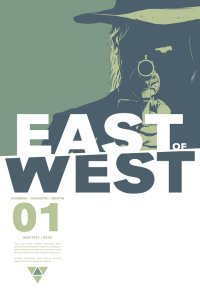
By Jeb D.
You could argue that, at this point, the idea of the post-apocalyptic Western is nearly as much of a cliché as was the “original” Western, set in the late 19th century. Both settings share a bleak sense of loneliness, lawlessness, and the vast sense of an unexplored territory, one that allows a man (generally) to operate according to his own code, no matter if that’s at odds with the more effete expectations of “civilization”: from The Road Warrior to Book of Eli, or the more overt gunslinging of Firefly, we’ve seen enough permutations on the juxtaposition of the Man With No Name against the backdrop of World’s End that a writer (or, given that this is comics, a writer/artist team) needs to have a pretty unique spin on the idea to stand out. There’s no question that Jonathan Hickman’s a man of ideas, and this first issue is simply brimming with them; in fact, I’d go so far as to say that it’s a bit overstuffed.
Back in the day, the American Civil War is taken in a spectacularly unexpected direction, and by the time our story begins, in 2064, we stand in the remains of an America fragmented into seven separate nations. We don’t yet know what happened in the interim, but there’s clearly a century worth of blood debts to be paid. Three of the legendary Four Horsemen “birth” themselves by digging up out of the ground, and the story then jumps forward to the “adult” versions, led by the formerly-missing Death, who is a typical Eastwood/Saint of Killers badass gunman (the tone of this first issue, in fact, is not worlds removed from Preacher). Familiar figures from history turn up in unexpected contexts, and there’s an important “Message” whose meaning likely underlies the wasteland that these four spectral-looking (but extremely corporeal) characters roam.
It’s an intriguing premise, no question, and virtually every panel poses a question or introduces a mystery (What’s up with the missing Fourth Horseman? What were the first two Great Awakenings? Do the “bones” and “bonds” that ward off the WhiteTower operate with science or magic? And what about the Chalice?). And while that’s a great way to keep readers coming back for more, things kind of flatten out when there’s so much of it: when the idea of the Four Horsemen loose on a devastated future earth is presented with the same level of intrigue as wondering why our protagonist gallops off on a giant mechanical cockroach, it’s not hard to suspect Hickman of simply tossing mysterious shit at the wall to see what sticks. And while I suppose he’s going for deliberate stylization, Hickman doesn’t help his cause by crafting clichés that have been at home in dozens of films we’ve seen, or comics we’ve read, over the years: the central scene is a shootout in a bar that’s basically a bloody, beat for beat variation on similar scenes from Tombstone or Rio Lobo.
Artist Nick Dragotta, so whimsically provocative when teamed with Hickman on FF, here goes balls-out in the other direction, making the devastated futurescape an intense character in the story, upping the ante visually when the script gets caught up in its derivative old-Westisms: if you’ve been jonesing for a Warren Ellis-Juan Jose Ryp style bloodbath recently, Dragotta and colorist Frank Martin deliver in spades. And, yes, since it’s a Hickman book, there are infographics, redolent of the recent Ultimates “Divided We Fall” storyline, and Colin Woodward’s American Nations.
No question, I’m onboard this series for a while, at least: I’m as intrigued as anyone by a good mystery, and there’s plenty here to choose from; I’m hoping that there will be some distinctive characterization and involving plot to go with it.
Rating: 




Out of a Possible 5 Stars